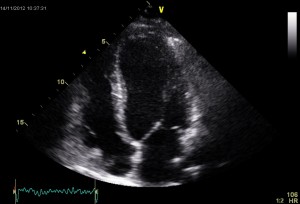
Download this patient information sheet
An exercise echo involves a baseline ultrasound (or echocardiogram) of the heart with repeat images taken soon after exercise on a treadmill. This compares the heart function at rest and after exercise to look for changes in heart function which may suggest heart problems.
An exercise echo gives important information regarding the performance of the heart during exercise stress. The echo images are examined in combination with a continuous ECG and blood pressure measurements which add to this information.
The response to exercise gives specific information about the blood supply to the heart muscle, and whether there are narrowings or blockages within arteries. It gives some information about the severity of such blockages, and the results of various treatments to improve blockages, including coronary stents, and heart surgery.
The exercise echo may also give information about heart valve function, and other aspects of heart function.
The test is in three phases 1) a baseline echo at rest, 2) a treadmill exercise test and 3) an echo and ECG monitoring in the immediate rest period after exercise.
Yes. You need suitable flat shoes and comfortable clothing. A medical gown can be used if needed. You should not do an exercise echo on a full stomach.
Yes, but these are very low. There is less than one in 10,000 risk of having a heart attack serious heart rhythm change or death during or immediately after the test. In addition, the amount of exercise needed to do the test will usually be less than or up to the most you might do during everyday activities, such that in many cases problems encountered with the test are actually best identified in the rooms setting, such that they can be dealt with promptly.